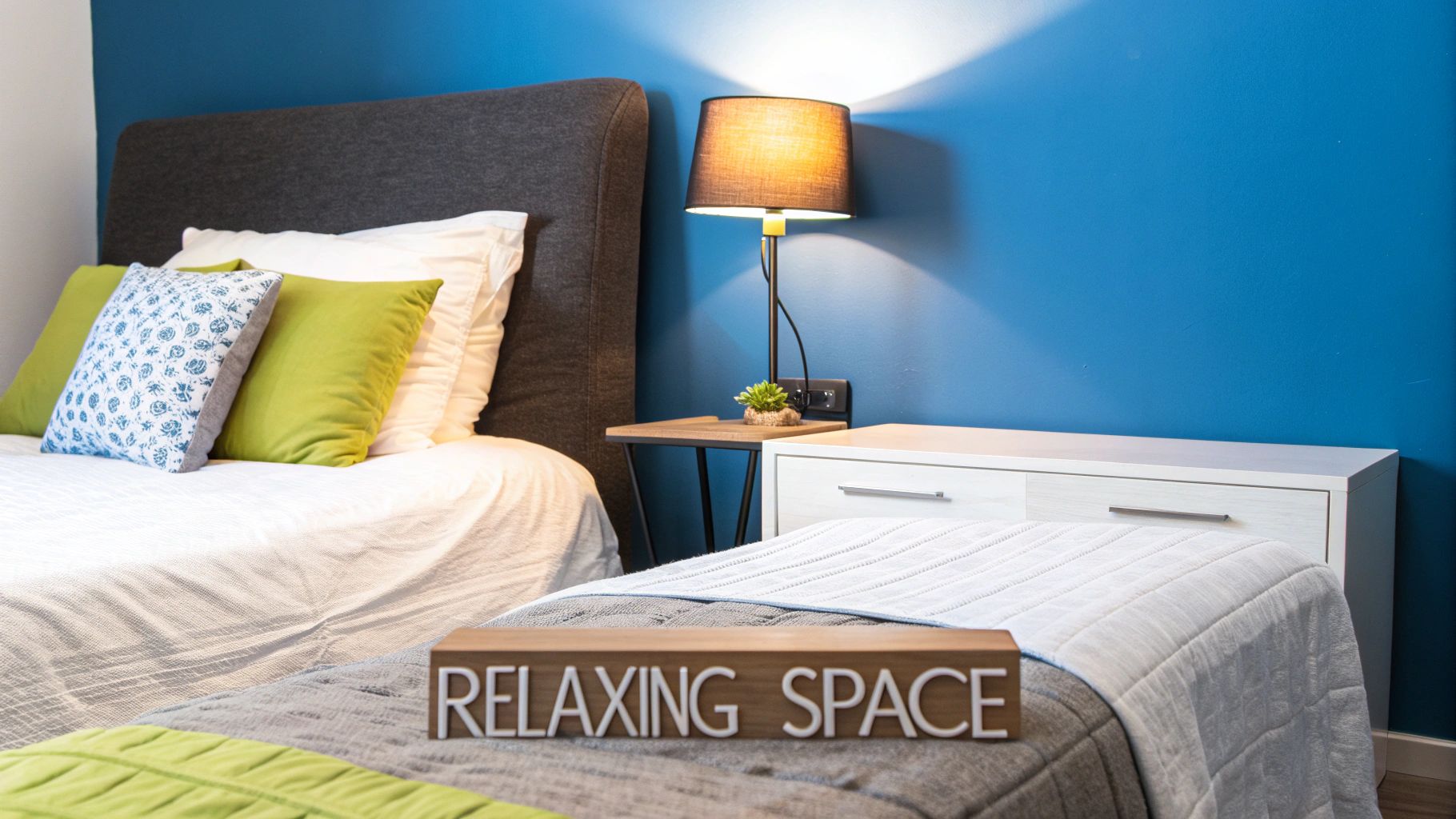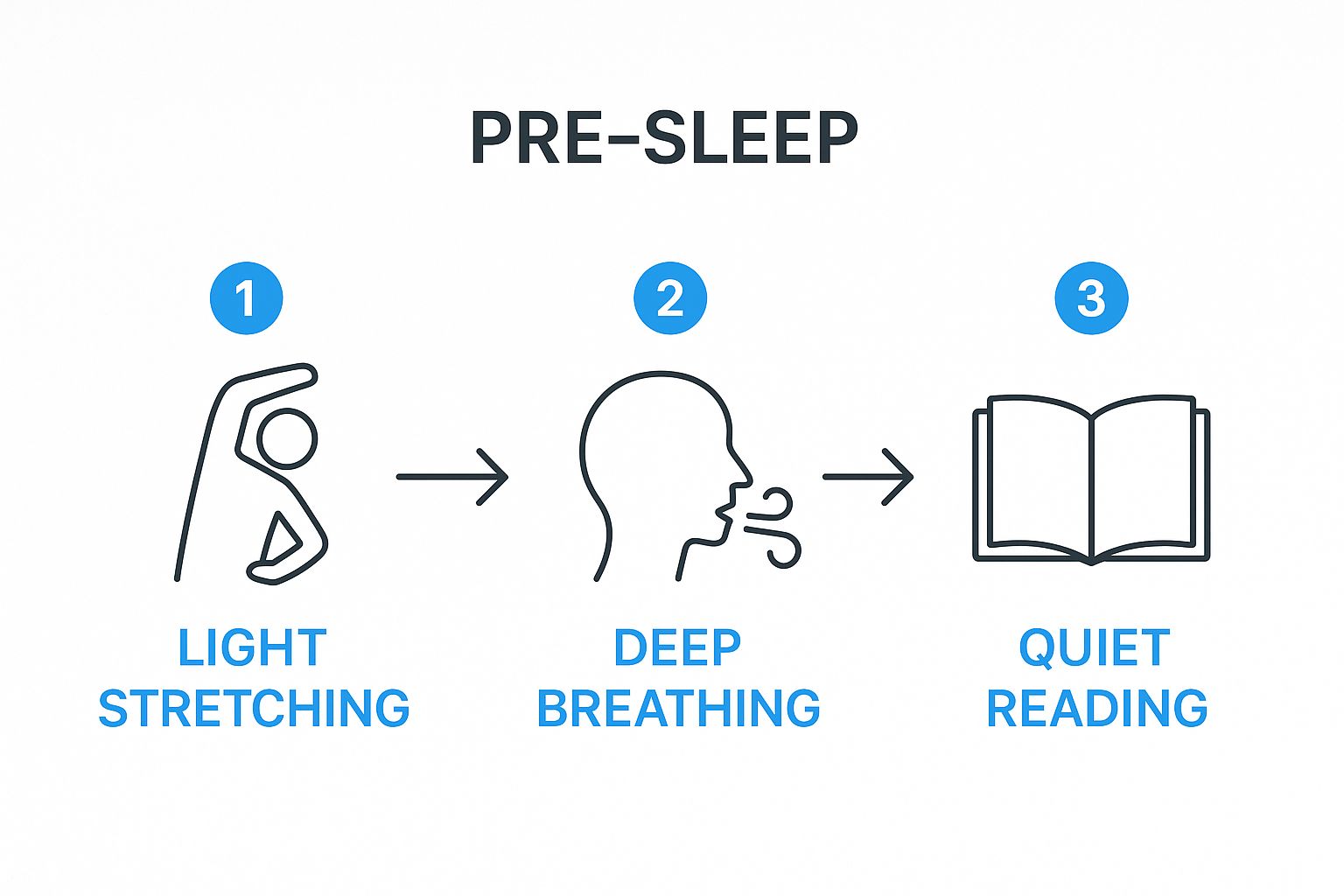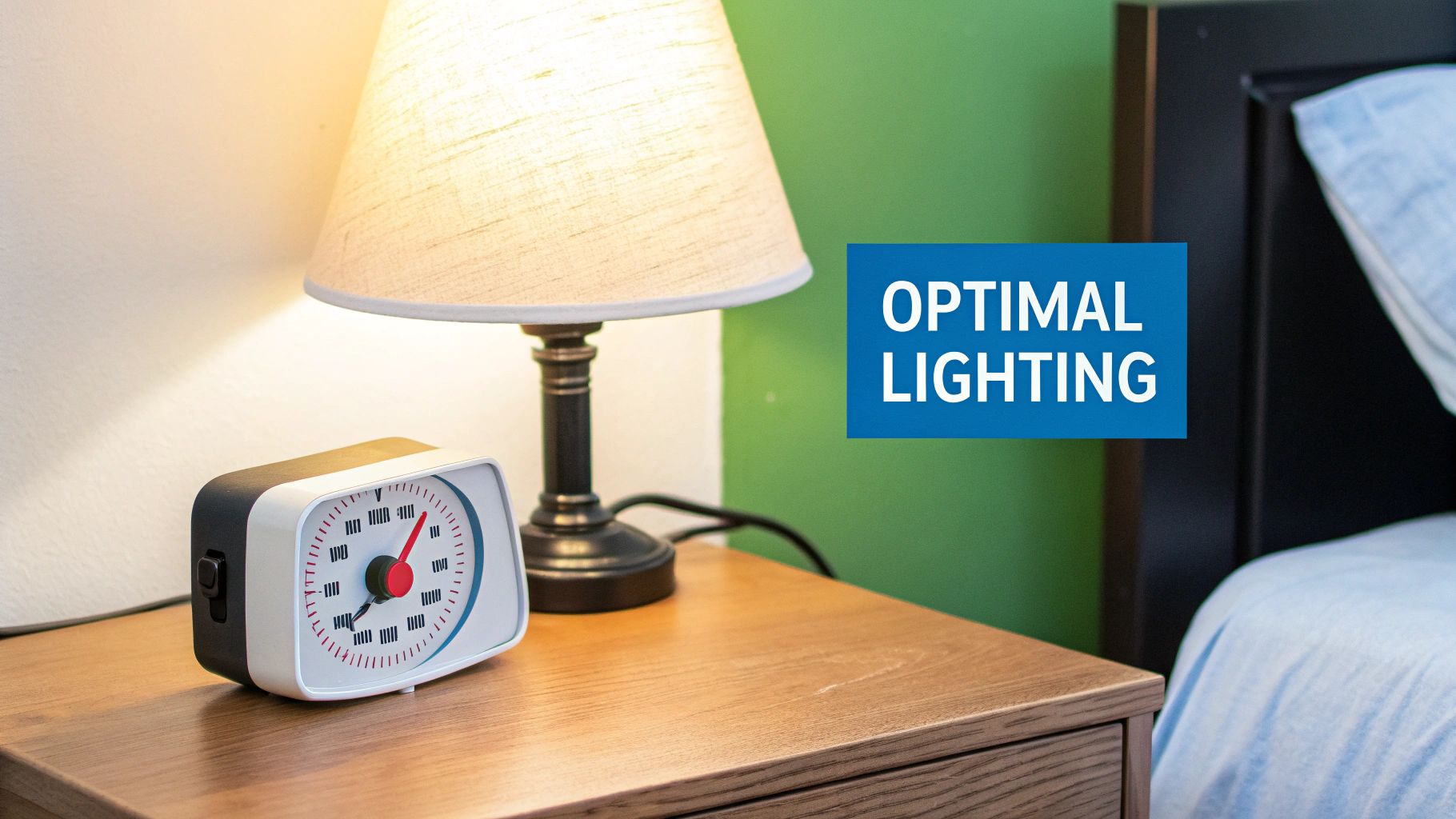If you're having a hard time getting to sleep, the problem probably isn't a lack of effort—it's more likely a flawed approach. A truly successful bedtime routine is a deliberate buffer zone between your busy day and a night of restful sleep. It’s not just a series of chores you rush through before turning out the lights.
Think of it this way: it’s all about sending clear, consistent signals to your brain that it's time to power down for the night.
Why Your Bedtime Routine Isn't Working

Does this sound familiar? You dim the lights, brush your teeth, and climb into bed, only to find your mind is suddenly racing faster than ever. You’ve followed all the standard advice, but sleep just won't come. This is a classic sign of a routine that fails to address the core issue: a brain that simply refuses to switch off.
So many of us treat our bedtime routine like a final sprint, blasting through tasks just to get into bed as quickly as possible. But this approach often backfires, keeping your nervous system on high alert. The goal isn't just to complete tasks; it's to create a gentle, gradual transition from the wired state of your day to a calm, relaxed state that welcomes sleep.
The Real Purpose of a Bedtime Routine
An effective evening ritual is built on consistency, not complexity. It's less about a rigid, hour-long checklist and more about creating predictable cues that your body learns to associate with sleep. These cues can be surprisingly simple yet incredibly powerful.
- Environmental Triggers: Lowering the thermostat by a few degrees, dimming the lights, or playing some soft ambient sounds are all signals to your internal clock that the day is winding down.
- Active Relaxation: This involves intentionally calming your mind and body. Think gentle stretching, a short meditation session, or even just a few minutes of deep breathing exercises.
- A Strategic Digital Detox: Powering down your screens at least an hour before bed is non-negotiable. The stimulating blue light they emit can seriously disrupt your body's natural melatonin production.
The most successful routine is one that becomes an automatic, comforting habit. It should feel less like a chore and more like a well-deserved reward at the end of a long day.
If you find that your mind is still buzzing with worries despite these efforts, it might be due to deeper issues. It can be helpful to understand some of the unexpected reasons you can't sleep to get more insight. The key is to build a personalized approach that actively calms both your environment and your internal state, setting the stage for truly restorative rest.
Crafting Your Ideal Sleep Environment
Your bedroom should be a sanctuary, a space dedicated entirely to rest and rejuvenation. It's easy to let it become a multi-purpose room that holds onto the day's stress, but getting ready for bed starts long before you pull back the covers. It begins with creating an environment that sends a clear signal to your brain: it’s time to unwind.
The foundational principles are refreshingly simple: keep your room cool, dark, and quiet. A cooler room temperature actually works with your body's natural pre-sleep dip in core temperature. Try aiming for somewhere around 65°F (18°C)—a range often pointed to as the sweet spot for deeper, more restorative rest.
Optimizing Light and Sound
Darkness isn't just a preference; it's a biological trigger for producing melatonin, the hormone that governs your sleep-wake cycle. Even small amounts of light from electronics or a streetlamp can throw a wrench in that process. Taking control of the light in your room is a non-negotiable, so it's worth learning how to choose effective window treatments like blackout curtains to achieve true darkness.
Sound is just as critical. A sudden, jarring noise can easily yank you out of the lighter stages of sleep, disrupting the whole cycle. To keep things peaceful, you have a few great options:
- A white noise machine can work wonders to mask disruptive sounds from outside.
- Soft ambient music or a sleep podcast can give your racing mind something gentle to focus on.
- Comfortable sleep headphones, like Bedphones, are perfect for listening without bothering a partner.
Your sleep environment is the foundation of your entire bedtime routine. Treating your bedroom as a space exclusively for sleep and relaxation strengthens the mental association between the room and rest, making it easier to fall asleep each night.
Beyond these basics, think about other sensory cues that encourage relaxation. A lavender diffuser, for instance, can fill the room with a calming scent that's been scientifically linked to reduced anxiety.
Ultimately, even a few small adjustments can have an outsized impact on your night. You can dive deeper into fine-tuning your space in our guide to how the sleep environment impacts sleep quality.
The Digital Detox That Prepares Your Brain for Sleep

Let's be real—your phone is probably the biggest thing standing between you and a solid night's sleep. Just telling yourself to "put it away" doesn't cut it. That habit is way too ingrained for most of us. What you need is an actual wind-down plan, one that understands why screens mess with our sleep in the first place.
The blue light blasting from your phone, tablet, and computer screen actively suppresses your body’s production of melatonin. That's the crucial hormone that tells your brain it's time to sleep. So while you're scrolling, your brain is getting mixed signals, staying alert and buzzing with information when it should be powering down. It’s like hitting the gas and the brake at the same time.
Establishing a Tech Curfew
The single most effective thing you can do is set a firm "tech curfew." Pick a hard stop for all screen time at least 60 to 90 minutes before you plan to actually fall asleep. This creates a much-needed buffer for your mind to shift gears and detach from the digital noise.
Instead of scrolling through another feed, it's time to rediscover some analog activities that genuinely calm your nervous system down.
- Read an actual book. The simple, linear act of reading a physical book is way less stimulating than jumping between a dozen different apps.
- Journal your thoughts. Getting all those racing thoughts and worries out of your head and onto a page can keep them from spinning around all night.
- Listen to a guided meditation. You can do this with your eyes closed, maybe with your phone placed face down across the room just playing the audio.
This screen-free time isn't about punishment; it's about reclaiming a peaceful transition into rest. It’s a deliberate choice to signal to your brain that the day is done and it's safe to unwind.
Ironically, even the tech meant to help us sleep can backfire. Sleep anxiety is a growing problem, with nearly 40% of Gen Z adults saying they experience it multiple times a week. This has led to a bizarre phenomenon called “orthosomnia”—an unhealthy obsession with getting perfect sleep scores on tracking devices, which just ramps up the stress. You can read more about this growing wellness trend and its impact.
The goal isn't to demonize all tech, but to use it wisely and not let it control your rest.
Mind And Body Relaxation Techniques That Actually Work
You’ve set the stage and your sleep sanctuary is ready. Now for the final, and maybe most important, piece of the puzzle: calming your internal world. The stress from the day tends to stick around in both your body and mind, making it tough to flip that “off” switch when your head hits the pillow. The trick is to be intentional about letting it all go.
Physical tension is a major culprit. Think about it—after a long day sitting at a desk or being on your feet, your muscles are tight and that keeps you feeling alert. Some simple, slow stretches focusing on your neck, shoulders, and lower back can work wonders. I like to do a gentle neck roll or a seated spinal twist right before climbing into bed. It’s amazing how much physical stress you can release in just a couple of minutes.
The Power of Conscious Breathing
Beyond stretching, your breath is one of the most powerful tools you have for shifting your nervous system out of "fight or flight" and into "rest and digest." Controlled breathing exercises can physically lower your heart rate and send a clear signal to your body that it’s safe to relax. One of the simplest and most effective methods out there is the 4-7-8 technique.
Here’s how it works:
- Inhale quietly through your nose for a count of four.
- Hold your breath for a count of seven.
- Exhale completely through your mouth for a count of eight, making a gentle whooshing sound.
That’s it. Repeat this cycle just three or four times. You'll likely feel a noticeable sense of calm wash over you. This exercise literally forces your body to slow down, making it an excellent primer for sleep.
To take your relaxation even deeper, why not add a warm, comforting drink to your routine? Check out this excellent guide to the best non-caffeinated teas like chamomile or peppermint for a soothing option that won’t keep you awake.
This simple flow shows how you can layer these calming activities for the best results.

As you can see, it’s a natural progression: you start by releasing physical tension with stretching, then move into quieting your mind with breathing and maybe some light reading.
Choosing Your Ideal Relaxation Technique
Everyone unwinds differently. Finding the best pre-sleep relaxation method often comes down to matching a technique to your lifestyle and personal needs. This table can help you figure out what might work best for you.
| Technique | Best For | Time Commitment | Key Benefit |
|---|---|---|---|
| Gentle Stretching | Releasing physical tension from the day. | 5-10 minutes | Eases muscle tightness and improves body awareness. |
| 4-7-8 Breathing | A racing mind and feelings of anxiety. | 2-5 minutes | Quickly activates the body's relaxation response. |
| Guided Meditation | Overthinking and struggling to detach from worries. | 10-20 minutes | Provides a gentle focus point to quiet mental chatter. |
| Sipping Herbal Tea | Creating a cozy, sensory-based wind-down ritual. | 10-15 minutes | The warmth and aroma can be incredibly soothing and comforting. |
Whether you have 5 minutes or 20, there's a technique here that can help you transition more smoothly from a busy day to a restful night. Experiment and see what feels right.
Finding Mindfulness and Stillness
Mindfulness gets a bad rap sometimes. People often think it means you have to completely empty your mind, which can feel impossible and honestly, a little intimidating. But that’s not it at all. It’s really just about paying attention to the present moment without judging it. Guided meditation is a fantastic way to dip your toes in.
Quietly listening to a guided meditation can help detach you from the day's worries, giving your mind a gentle focus point instead of letting it race.
There are tons of apps and audio tracks out there to help you get started. If you want to find a practice specifically created to help you drift off, you can explore our detailed guide on using deep sleep meditation for better rest.
By combining these different techniques, you’re not just going to bed—you’re creating a powerful ritual for both your mind and body.
Crafting Your Own Wind-Down Ritual

Okay, this is where we put it all together and build a practical plan you can actually stick with. A good bedtime routine isn't some rigid, hour-long checklist that just adds more stress to your day. The real secret? Consistency over perfection.
Even a quick 15-minute routine can make a world of difference. When you repeat the same simple actions every night, you're literally training your body's internal clock—your circadian rhythm. This predictable pattern is the cornerstone of regulating your sleep-wake cycle and finally getting that deep, reliable rest you've been missing.
Start Small and Chain Your Habits Together
Don't try to do everything at once. That's a surefire way to get overwhelmed and quit. Just pick two or three simple activities from the ideas we've covered and string them together into a sequence. It could be as basic as lowering the thermostat, doing a few gentle stretches, and then reading a chapter of a book.
Here’s a simple, adaptable template you can make your own:
- Set the Scene (1 minute): Dim the lights around the house and turn down the thermostat. This is your first signal that the day is ending.
- Go Screen-Free (Starts 60 mins before bed): Plug your phone in to charge—across the room, not on your nightstand.
- Relaxation Time (10 minutes): Pop in your Bedphones to listen to a chill podcast or just do a simple breathing exercise.
- Final Step (4 minutes): Brush your teeth, get into your pajamas, and slide into bed.
This whole thing takes maybe 15 minutes, but it creates a powerful buffer between the chaos of your day and the calm of your night.
A personalized routine isn't about adding more chores to your list. It's about creating a quiet, intentional ritual that tells your nervous system it's safe to power down. Think of it as your personal transition into a state of rest.
It's also worth remembering that sleep needs aren't one-size-fits-all. They can vary a lot based on your lifestyle and even where you live. For example, data shows that South African women average about 9 hours and 17 minutes of sleep, while women in the United States get closer to 8 hours and 52 minutes. These differences really drive home why a personalized approach is so critical. You can check out more fascinating facts in these global sleeping statistics on Market.us.
Once your short routine starts to feel like second nature, then you can think about adding other things, like sipping a cup of herbal tea or spending five minutes journaling. The goal is to build a foundation that feels easy and inviting, turning the whole process into a part of your day you actually look forward to.
Common Bedtime Questions Answered
Even with the best routine in the world, some nights are just harder than others. You can do everything right, but your brain might decide it's the perfect time to solve all of life's problems. It happens to everyone. Let's walk through a few of the most common snags you might hit.
My Mind Is Racing. What Do I Do?
This is the classic bedtime problem. You lie down, and suddenly your mind is flooded with to-do lists, worries, and random thoughts you haven't had all day. Trying to force these thoughts away usually just makes them louder.
Instead, try a "brain dump." I keep a simple notebook on my nightstand for this exact reason. Take just five minutes and scribble down everything swirling in your head. Getting it all out on paper can feel like closing a bunch of open tabs on your computer—it provides a surprising amount of relief and tells your brain it's okay to let go for the night.
What If I Can't Fall Asleep? The 20-Minute Rule
So you've been lying in bed for what feels like an eternity, and sleep is nowhere in sight. Staring at the ceiling and getting frustrated is the worst thing you can do. It's time for the 20-minute rule.
If you haven’t drifted off after about 20 minutes, get out of bed.
Head to another room and do something genuinely boring and relaxing. Think reading a dull book (not a thriller!) or listening to some quiet ambient music in very dim light. The goal is to break the connection your brain is making between "bed" and "frustration." Once you feel that heavy-lidded sleepiness coming back, then it's time to return to bed.
Don't ever try to force sleep. Lying there feeling anxious about being awake is completely counterproductive. Getting up for a few minutes to reset is often the fastest way to actually get to sleep.
A quick word on sleep aids: while it can be tempting to reach for an over-the-counter solution, many can leave you feeling groggy and out of it the next day. It's always a better bet to build solid, sustainable habits first. If you're still struggling, it's a good idea to chat with a healthcare professional before relying on supplements or medication.
Ready to make your relaxation time even more effective? DubsLabs Bedphones are designed for ultimate comfort, allowing you to listen to calming music or guided meditations without bulky headphones. Discover how they can perfect your wind-down ritual at https://www.dubslabs.com.











































